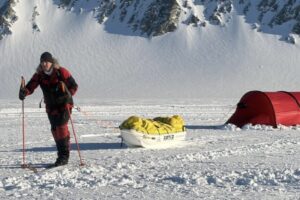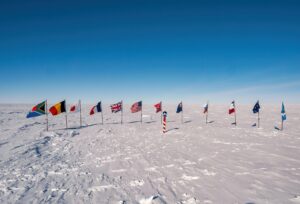Polar Force. Energy Field. Permafrost. Weather Report.
If those sound like the names of 1970s jazz-fusion bands, you’re not far from the truth. They’re album titles from a growing sub-genre of recording: the sounds of melting ice and changing weather.
While many documentaries have explored the visual evidence of our warming world, a cross-section of talented people have begun delving into the auditory equivalent. From climate professors to environmental activists to ambient music artists — records of Earth’s climatic extremes offer an aural insight into the forces reshaping our world.
Dedicated readers of ExplorersWeb will know that climate change is quickly transforming the Alps, causing increased danger for climbers and headaches for land managers. But have you listened to the melting permafrost and contracting glaciers of the Swiss Alps?
Lovers of polar adventure may understand the rigid rules of Antarctic exploration, but have you heard the hair-raising recordings of a violent blizzard?
From art projects to online archives, there’s a fascinating new body of sound worth exploring.
Jana Winderen
Norwegian musician and activist Jana Winderen has been transforming natural sounds into ambient collages for more than 20 years.
Much of her work focuses on the bizarre, otherworldly tones of cracking, melting ice. Recordings from polar regions like Greenland include smooth, descending glissandos like a diving missile or percussive slaps like a bebop drummer. Her albums prove there’s an astounding diversity and clarity to the music of melting ice.
Her 2010 work Energy Field creates a tone poem to icy landscapes teeming with the often unseen drama of frozen rivers and moving glaciers.
“I made an early decision to work with the immaterial material that sound is, however physical it can be,” she told Forbes in 2021. “You get quite a physical experience, but it doesn’t take up any space and I reuse my recording equipment.
“If you see an object, you want to buy it. I’d rather people have an experience that they can carry with them and associate with instead of actually owning an object, something that doesn’t necessarily cost anything to come and experience, just the act of listening itself.”
Philip Samartzis
It only took one Antarctic blizzard for Australian sound artist and researcher Philip Samartzis to realize the transformative potential of ice song.
He’s been recording sounds at the edge of the world since 2010 when he had an arts fellowship to document the acoustic environment of Australia’s Davis Research Station in Antarctica, which resulted in the recording above.
Since then, he’s taken his work to the Swiss Alps. His new album Atmospheres and Disturbances, out this month, tracks the rapidly disintegrating environment through the sonic screams of a melting landscape.
“When I talk to scientists about climate change, everyone’s all talked out,” he said in The New York Times. “Essentially everyone knows, so it’s, ‘Why should I listen to you and your report?’” Samartzis said. “These recordings may not be scientifically sound, but it’s a whole other way of communicating knowledge, a different aperture of experience.”
Thomas Koner
German producer Thomas Koner has been making music from melting ice for longer than most. He started back in the 1990s when the experience of watching fog flow around a Norwegian glacier changed his life.
That led him to create a trilogy of ambient music albums inspired by the awe of Arctic spaces and the slow inevitability of its vast ice formations. The artist’s 2012 album Novaya Zemlya — a testament to glaciers in the Arctic archipelago — might be Koner’s last work.
Albums like Daikan, above, evoke an undeniable sense of the isolation and indifference felt at the world’s ice extremes.
Need still more ice music in your life? Check out this nifty Spotify playlist created by The New York Times. The next time you need something chill and ambient for your meditation/yoga/chill time — consider one of these icy reflections on a changing world.





